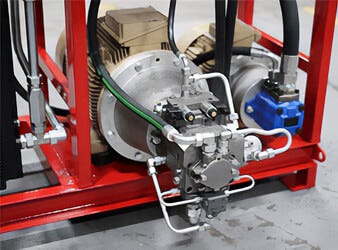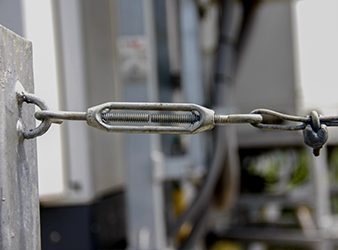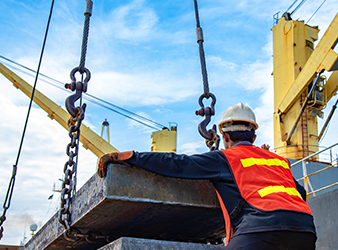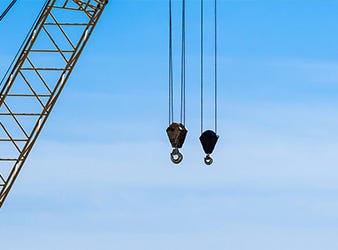Guide to Eye Bolts: Applications, Ratings & Installation
- By Empire Rigging
- Oct 10, 2025
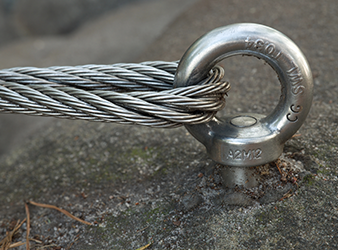
Eye bolts are essential in the rigging industry—simple in design but vital for safety and effectiveness when lifting, anchoring, and securing loads. Whether you’re lifting equipment, anchoring to concrete, or establishing a temporary rigging point, choosing the right eye bolt makes all the difference.
Below, we’ll cover everything you need to know about eye bolts: their uses, different types, weight capacities, and best practices for safe installation.
What Are Eye Bolts Used For?
Eye bolts are threaded fasteners with a loop (eye) at one end, intended to attach slings, hooks, chains, or ropes. They function as anchor points for lifting and rigging tasks across various industries.
• Rigging and Lifting Operations: Often designed as part of a load to provide secure lifting points.
• Anchoring and Tie-Downs: Used to attach guy wires, chains, or cables to secure equipment or materials.
• Machinery Lifting: Machinery eye bolts are embedded into heavy equipment to aid in relocation or installation.
• Construction and Infrastructure: Used to stabilize temporary structures or suspend equipment.
• Marine and Industrial Environments: Stainless eye bolts resist corrosion and are frequently used in shipyards and factories.
Their versatility makes them essential for everything from light-duty construction to heavy industrial lifts. Eye bolts are highly adaptable. In industrial rigging, they’re used to lift heavy equipment, suspend structural components, or anchor tensioning systems like guy wires and chain slings. In warehouses, they're mounted into ceilings or concrete floors for overhead hoists or tie-down points. Maintenance crews often use machinery eye bolts as permanent lifting lugs for moving motors, pumps, and gearboxes. Because they can be installed in metal, wood, or concrete, eye bolts are equally valuable in construction, marine, utility, and transportation environments.
What Are the Main Types of Eye Bolts?
Choosing the right eye bolt begins with understanding the various types and their specific uses.
Shoulder Eye Bolts
• Designed for angular loading (usually up to 45°) as well as vertical lifts.
• The shoulder helps prevent bending and shear when side loads are applied.
• Ideal for dynamic or multi-directional lifts.
Plain (Non-Shoulder) Eye Bolts
• It may hide internal damage; it requires a thorough inspection.
• Not suitable for sharp loads without protection on the edges.
Machinery Eye Bolts
• Forged for permanent installation into equipment.
• Heavy-duty design for repeated use.
• Often used in manufacturing and maintenance operations.
Swivel Eye Bolts
• Feature a rotating head or eye.
• Prevent torsion on the load by allowing full 360° rotation.
• Ideal for off-center or shifting loads.
Ring Bolts / Lifting Rings
• Similar to eye bolts but feature a welded or forged ring for additional articulation.
• Useful for multi-leg sling arrangements and loads that shift during lifting.
Eye Screws / Lag Eye Bolts
• Threaded for wood or soft materials.
• Common in light-duty anchoring or hardware applications.
• Not rated for lifting—should never be used in overhead rigging.
Each type of eye bolt serves a specific purpose based on load direction, material, and application. Shoulder eye bolts are suitable for angled pulls and rotating loads, while plain eye bolts should only be used when loads are strictly vertical. Swivel eye bolts are increasingly popular for dynamic lifting situations where loads might shift or twist, as they help reduce stress and lower the risk of failure. Ring bolts, with their full loop, provide even more flexibility for multi-leg slings or uneven loads. For light-duty tasks like hanging cables, securing signage, or tethering tarps, lag eye bolts (screw-in style) are a quick and easy solution—but never use them for lifting. Rigging operations require forged, load-rated eye bolts.
Eye Bolt Materials & Finishes
Material selection affects durability, corrosion resistance, and strength:
• Forged Carbon Steel: a standard option for lifting and rigging; heat-treated to enhance strength.
• Stainless Steel: resists corrosion and is ideal for use in marine or outdoor environments.
• Galvanized Steel: zinc-coated for moderate corrosion resistance; more affordable than stainless.
• Plated Eye Bolts: Intended for indoor use or non-lifting purposes only.
Material choice depends on the environment and type of load. Forged carbon steel is a standard option in most industrial settings due to its strength and cost-effectiveness. In humid or saltwater environments—such as docks, ships, or wastewater facilities—stainless steel is worth the extra expense to prevent rust and deterioration. Galvanized steel offers a good compromise, providing corrosion resistance at a reasonable price. When choosing plated eye bolts, remember they are generally for indoor or static use only—plating can chip or wear away in harsh conditions. For critical lifting, always ensure that the eye bolt is forged, not cast or welded, and that a recognized manufacturer has rated it.
How Much Weight Will an Eye Bolt Hold?
One of the most common questions is: How much weight can an eye bolt safely support?
The answer depends on several factors:
Working Load Limit (WLL)
Each eye bolt is rated for a maximum safe working load when installed correctly and under ideal conditions. For example:
• A ½ in forged shoulder eye bolt might be rated for 2,200 lb in a vertical lift.
• At a 45° angle, the rating can drop by 30%–70%, depending on the manufacturer.
Type of Load
• Vertical Load: Safe and predictable. Use full WLL.
• Angular Load: Reduces capacity significantly. Only shoulder bolts should be used.
• Side Load on Plain Eye Bolts: Can result in failure—never recommended.
Thread Engagement
• Eye bolts must be fully threaded into the load.
• At least 90% of the bolt's threaded shank should be engaged.
• Use a nut and washer if securing through an unthreaded plate or structure.
Bolt Size and Material
• Larger diameters = higher load capacity.
• Always follow manufacturer specifications for exact ratings.
The load capacity of an eye bolt isn’t fixed—it depends on how it’s installed, the angle, and the hardware used. A vertical lift with the full thread engaged into steel can safely handle the bolt’s entire Working Load Limit (WLL). However, even a slight tilt in the sling or chain can significantly lower that capacity. For instance, a shoulder eye bolt rated for 1,500 lb. may only support between 750 and 900 lb. when at a 45° angle.
The length and type of thread engagement are also crucial. If the bolt isn’t fully seated or installed into a soft material like wood or thin metal, the effective WLL can fall below safe limits. That’s why it’s important to use WLL charts, follow manufacturer guidelines, and apply a safety factor of 5:1 or more for overhead lifts.
Proper Installation Best Practices
Proper installation is the foundation of eye bolt safety. Follow these key steps:
- Use Shoulder Bolts for Angular Loads: If the load is not purely vertical, a shoulder bolt is required.
- Ensure the Shoulder Sits Flush Against the Surface. For shoulder bolts, the shoulder must rest evenly to ensure proper load distribution.
- Ensure Full Thread Engagement: At least 90% of the bolt length must be threaded into the base material.
- Use Compatible Slings and Hardware: Connect only to rated shackles, hooks, or chain—no makeshift attachments.
- Inspect Before Each Use: Check for signs of wear, corrosion, cracks, or deformation. Replace immediately if damage is found.
- Avoid Side Loading on Non-Shoulder Bolts: This can cause the bolt to bend or snap, weakening the load.
Even the strongest eye bolt can fail if installed incorrectly. Follow these essential steps to ensure safety: inspect the bolt and mounting surface, verify that threads are clean and properly torqued, and confirm alignment with the load direction. For through-hole applications, use washers and backing plates. Avoid forcing eye bolts to "clock" into a specific position—if alignment is off, consider using a swivel hoist ring instead. For permanent setups, adhere to torque specifications and use thread lubricants according to the bolt type and application.
Eye Bolt Safety Tips & Compliance
When lifting personnel or heavy equipment, there is no room for shortcuts. Follow these safety guidelines:
• ASME B30.26 Compliance: All lifting hardware, including eye bolts, must conform to these safety standards.
• Visual Inspections: Always check eye bolts prior to lifting.
• Avoid Modifications: Never grind, bend, or alter eye bolts.
• No Overloading: Always respect the WLL, including considering angle reductions.
• Use lock nuts or thread lockers to prevent loosening caused by vibration or rotation.
Safety is critical. According to ASME B30.26, rigging hardware must pass strict load tests and have proper labels. Eye bolts used for lifting must be clearly marked with the manufacturer’s name or ID, and load ratings should be traceable. Avoid mixing hardware from unknown sources, and never use non-rated parts as substitutes.
Inspections should be carried out before every lift and periodically during long-term installations. Common warning signs include bending, corrosion, elongated eyes, and stripped threads. If in doubt, replace it.
For added safety, use thread-locking compounds or jam nuts to prevent loosening from vibration or shock. If lifting at an angle, consider using a swivel hoist ring instead of a fixed eye bolt.
Eye bolts may seem like simple components, but their role in rigging and lifting is quite complex. With the right choice, proper installation, and routine safety inspections, they offer a secure and durable solution for lifting, anchoring, and stabilization tasks.
From industrial equipment to on-site construction work, understanding your eye bolt types, load ratings, and safe usage practices is essential for a successful—and safe—rigging operation.
Looking for eye bolts you can trust? Contact Empire Rigging today through our contact form, call 844-728-1771, or browse our full selection of lifting hardware online.


